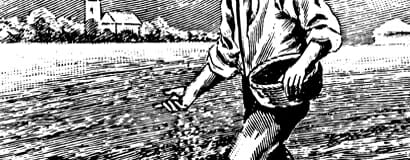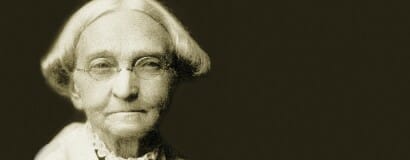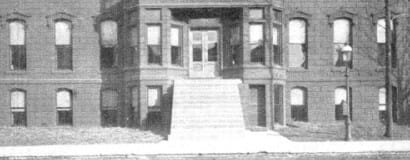Where we come from

1824
The Baptist General Tract Society is founded “to disseminate evangelical truth, and to inculcate sound morals, by the distribution of tracts.” The society’s seeds are sown when the newly ordained Rev. Noah Davis, pastor of the Baptist Church in Norfolk, Va., writes a letter to former classmate J.D. Knowles at Columbia College, Washington, D.C., about organizing such a society.

1832
The first home missionary of The American Baptist Home Mission Society, John Mason Peck is establishing churches and schools.…1832
The first home missionary of The American Baptist Home Mission Society, John Mason Peck is establishing churches and schools, traveling thousands of miles on horseback to distribute Bibles and tracts to those living on America’s frontier. When Jonathan Going explores the conditions of Baptists in the West, Peck guides him for three months through the Mississippi Valley and around its tributaries. Before parting, they agree to start the new organization. The American Baptist Home Mission Society is founded by Peck and Going “to promote the preaching of the gospel in North America,” establish churches and support ministry among the unchurched and destitute.
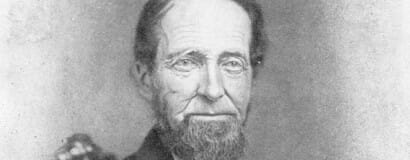
1836
One hundred-fifty home missionaries—including Thomas Ward Merrill—are ministering and spreading God’s Good News …1836
One hundred-fifty home missionaries—including Thomas Ward Merrill—are ministering and spreading God’s Good News in 14 U.S. states, two territories and two provinces. Missionaries are met with opposition from all sides, including churches fearing their autonomy threatened. However, missionaries also meet with success. As one writes, “I have traveled this year 2,037 miles, preached 264 times, baptized 52, organized one church, ordained one minister, and constituted three churches into an association.”
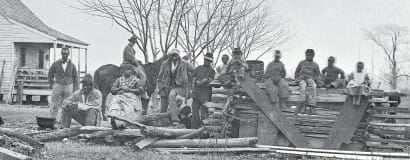
1845
The American Baptist Home Mission Society refuses missionary appointment to slave owners.…1845
The American Baptist Home Mission Society refuses missionary appointment to slave owners. As a result, Southerners withhold funding from national societies, organizing their own Southern Baptist Convention. Home missionaries appointed prior to the division choose between the old board and the new Southern board. All but one remain loyal.

1862
The same year that Abraham Lincoln issues the Emancipation Proclamation, the Home Mission Society’s board decides to educate emancipated slaves.…1862
The same year that Abraham Lincoln issued the Emancipation Proclamation, the Home Mission Society’s board decided “to take immediate steps to supply with Christian instruction, by means of missionaries and teachers, the emancipated slaves … and also to inaugurate a system of operation for carrying the Gospel alike to bond and free throughout the whole Southern section of our country, so fast and so far as the progress of our arms and the restoration of order and law shall open the way.”
1863
Joanna P. Moore begins to minister, without pay, among freed people living in refugee camps. She teaches reading, writing, Bible lessons and homemaking skills. She, like other single women, seeks to answer God’s call, but The American Baptist Home Mission Society refuses to appoint them as missionaries. Later, she establishes “Fireside Schools” and produces “Hope” magazine that reaches into 36,000 homes. Moore and Kitty Lewis, a former slave, later establish Faith Home for the Aged for freed women.
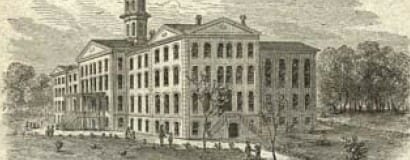
1865
Schools for freed people begin in humble settings, such as the abandoned Lumpkin’s Jail …1865
Schools for freed people begin in humble settings, such as the abandoned Lumpkin’s Jail and former slave quarters where Richmond Theological Seminary (now Virginia Union University) was founded. ABHMS solicits for a special “Freedmen’s Fund” that supports dozens of educational institutions. Some institutions originally begun by African Americans, such as Arkansas Baptist College in Little Rock, are rescued with ABHMS funds, and the society makes annual appropriations to Atlanta Baptist Female Seminary (now Spelman College)—begun in the basement of Friendship Baptist Church.

1877
The Women’s Baptist Home Mission Society (WBHMS), Chicago, and the Woman’s American Baptist Home Mission Society (WABHMS), Boston, are founded…1877
The Women’s Baptist Home Mission Society (WBHMS), Chicago, and the Woman’s American Baptist Home Mission Society (WABHMS), Boston, are founded, in part because of Joanna P. Moore’s repeated requests for help. Unpaid up to this point, Moore now becomes the WBHMS’ first fully commissioned paid missionary.

1880
William J. Simmons is selected by The American Baptist Home Mission Society to lead a struggling school in Louisville, Ky. He later becomes the first African American…1880
William J. Simmons is selected by The American Baptist Home Mission Society to lead a struggling school in Louisville, Ky. He later becomes the first African American to serve as the society’s district secretary for southern states. Born a slave, he was sent North with his mother, where they were freed. At age 18, he joined a Baptist church following a conversion experience. He was educated at the University of Rochester and Howard University.
1881
The WBHMS opens its Baptist Missionary Training School in Chicago. While its primary purpose is to prepare American Baptist women for domestic mission work, it welcomes women from any denomination seeking to prepare for domestic or foreign mission work.

1909
The WBHMS and the WABHMS merge to become the Woman’s American Baptist Home Mission Society…1909
The WBHMS and the WABHMS merge to become the Woman’s American Baptist Home Mission Society. A hallmark of the new mission focus is the establishing of Christian centers to minister especially to populations in congested cities and industrial areas.

1928
Santiago Soto-Fontánez becomes an American Baptist home missionary, teaching at a mission school in El Salvador. He later serves new churches in Puerto Rico…1928
Santiago Soto-Fontánez becomes an American Baptist home missionary, teaching at a mission school in El Salvador. He later serves new churches in Puerto Rico and New York City, where a tiny Brooklyn storefront mission grows to 400 members, providing a model for Hispanic churches across the country. He was born in Caguas, Puerto Rico. His life was touched by American Baptist home missionaries after the Spanish-American War.
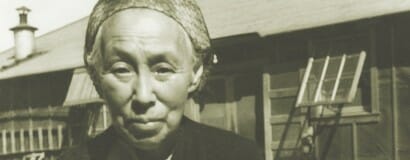
1942
American Baptists minister to Japanese-Americans unjustly imprisoned in U.S. internment camps…1942
American Baptists minister to Japanese-Americans unjustly imprisoned in U.S. internment camps following Japan’s attack on Pearl Harbor. While missionaries reach through the barbed wire with the gospel and supplies, The American Baptist Home Mission Societies secures educational and employment releases for individuals. Learn more by viewing “A Church Stands With Its People,” a video produced for the 70th anniversary of President Franklin D. Roosevelt’s signing of the executive order that instituted the camps.

1948
Ioleta Hunt McElhaney becomes the first Native American woman to receive full missionary appointment under the Woman’s American Baptist Home…1948
Ioleta Hunt McElhaney becomes the first Native American woman to receive full missionary appointment under the Woman’s American Baptist Home Mission Society. She serves at Rainy Mountain Kiowa Indian Baptist Church and Saddle Mountain Mission, both in Oklahoma. As a child, she learned of Jesus while her parents worked with Baptist missionaries. She graduated from Keuka College as the first Kiowa woman to earn a liberal arts degree.

1955
The American Baptist Home Mission Society and the Woman’s American Baptist Home Mission Society combine boards, staff and mission programs…1955
The American Baptist Home Mission Society and the Woman’s American Baptist Home Mission Society combine boards, staff and mission programs. Mission foci include juvenile protection, racial tolerance, Christian friendliness and resettlement of displaced persons following World War II.

1956
Jitsuo Morikawa is appointed National Ministries’ director of Evangelism. Born into a Buddhist family who immigrated to British Columbia from Japan, he learned…1956
Jitsuo Morikawa is appointed National Ministries’ director of Evangelism. Born into a Buddhist family who immigrated to British Columbia from Japan, he learned of Jesus from a Christian neighbor. At age 16, he devoted his life to Christ and felt a calling to evangelism. During World War II, he and his wife were shipped to the Poston Relocation Center in Arizona. The experience resulted in his strong belief that not only people but also institutions must be evangelized.

1960s
Santiago Soto-Fontánez develops much-needed Spanish resources as director of Spanish Work for the Baptist City Society of New York.1960s
Santiago Soto-Fontánez develops much-needed Spanish resources as director of Spanish Work for the Baptist City Society of New York.
1969
The Office of Governmental Relations opens in Washington, D.C., to encourage both American Baptist participation in the political process and public policy advocacy as Christian witness. The office represents the public policy concerns of The American Baptist Home Mission Society, collaborating with other denominational offices and organizations. Over the years, the office focuses on a broad range of concerns including poverty, hunger, housing, health care, and civil and human rights.

1972
As part of a denominational structural study, The American Baptist Home Mission Society begins doing ministry as National Ministries…1972
As part of a denominational structural study, The American Baptist Home Mission Society begins doing ministry as National Ministries. By the end of the year, all mission in Latin America—except for Puerto Rico—is transferred to International Ministries.

2001
National Ministries and its partners engage in a “Shalom Response” to the terrorism of Sept.11…2001
National Ministries and its partners engage in a “Shalom Response” to the terrorism of Sept.11, reaching out in both New York City and Washington, D.C. In addition to distributing $1,656,717 in One Great Hour of Sharing funds, Ground Zero becomes National Ministries’ parish, as American Baptist pastors, chaplains, church planters and volunteers from across the United States minister to those affected by the tragedy.
2003
National Ministries absorbs Educational Ministries, bringing under its umbrella the denomination’s discipleship, education and publishing ministries, including Judson Press. Educational Ministries had stemmed from the Baptist General Tract Society and the American Baptist Education Society.

2005
National Ministries is among the first responders to the ecumenical call for disaster relief in the Gulf Coast …2005
National Ministries is among the first responders to the ecumenical call for disaster relief in the Gulf Coast following hurricanes Katrina and Rita. The organization has since spearheaded its own efforts, returning to the area every year. From 2005 to 2015, the organization has organized 5,236 volunteers along the Gulf Coast, including 957 volunteers for the annual “Home Mission: ’Til the Work is Done” in the Lower 9th Ward.

2010
National Ministries reclaims its identity as American Baptist Home Mission Societies (ABHMS)…2010
National Ministries reclaims its identity as American Baptist Home Mission Societies (ABHMS) with a day of celebration on April 27. Staff travel from the Mission Center in Valley Forge, Pa., to attend services at Mariners’ Temple Baptist Church and other New York City locations. ABHMS is historically linked to Mariners’ Temple (then known as Oliver Street Baptist Church), where, in 1832, the Sixth Triennial Convention recessed to the nearby Mulberry Street Baptist Church to found The American Baptist Home Mission Society. The society held Mariners’ Temple’s deed in trust and appointed missionaries to serve there.

2015
As issues of race, religion, culture and class increasingly divide communities and spark violence, ABHMS debuts “Space for Grace,”…2015
As issues of race, religion, culture and class increasingly divide communities and spark violence, ABHMS debuts “Space for Grace,” a recurring national gathering that engages individuals of diverse faith traditions with healing conversations, artistic expressions and quiet spaces. The highly-rated premiere event also serves to both celebrate retiring Executive Director Dr. Aidsand F. Wright-Riggins III’s 24 years at the helm and to welcome new Executive Director Dr. Jeffrey Haggray.
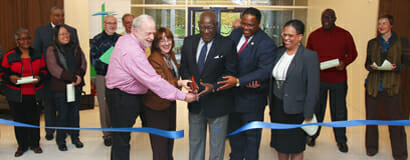
2018
ABHMS, American Baptist Extension Corporation and American Baptist Women’s Ministries relocate to a renovated building in King of Prussia, Pa. “We open these doors in a spirit of Christian friendship and welcome to all who will enter here in a spirit of love, peace, justice and community,” said the Rev. Dr. Clifford I. Johnson, president…2018
ABHMS, American Baptist Extension Corporation and American Baptist Women’s Ministries relocate to a renovated building in King of Prussia, Pa. “We open these doors in a spirit of Christian friendship and welcome to all who will enter here in a spirit of love, peace, justice and community,” said the Rev. Dr. Clifford I. Johnson, president of ABHMS’ board of directors, during the ribbon-cutting ceremony.
American Baptist Home Mission Societies finds its roots in several American Baptist mission societies. One of those is The American Baptist Home Mission Society, established in New York City in 1832 to preach the gospel, establish churches and support ministry among the unchurched and destitute. That same year the society sent 50 missionaries across the eastern and central United States to spread God’s Good News, and American Baptists have been planting churches—as well as schools, children’s homes, hospitals and nursing homes—winning souls for Christ, and speaking out for social and economic justice ever since. By 1836, 150 home missionaries were at work in 14 states, two territories and two provinces. Women wanted to help with the work of answering God’s call, but The American Baptist Home Mission Society refused to appoint single women as missionaries. In response, the Women’s Baptist Home Mission Society (WBHMS), based in Chicago, was founded in 1877, and Joanna P. Moore became its first fully commissioned missionary. Another women’s society, the Woman’s American Baptist Home Mission Society (WABHMS) was also founded in 1877 in Boston “to extend the kingdom of God among the women and children of America.” Over the next century, missionaries expanded American Baptist ministry by:
- Founding 27 institutions of higher education for Freed People after the Civil War;
- Sending an envoy to Washington to work for treaties favorable to Native Americans;
- Opening a Baptist Missionary Training School in Chicago;
- Appointing missionaries to serve in Michigan, New York, Puerto Rico, Alaska and Arizona;
- Ministering among Japanese Americans in internment camps during World War II; and
- Leading the way with Church World Service, following World War II, to relocate thousands of refugees to safe homes.
The two women’s societies consolidated their work in 1909 under the name Woman’s American Baptist Home Mission Society. In 1955, The American Baptist Home Mission Society and WABHMS merged their work; then in 1972, the societies began carrying out mission as National Ministries. In 2003, National Ministries added the denomination’s ministries of discipleship, education and publishing—including Judson Press—to its work when it absorbed Educational Ministries, which found its roots in the Baptist General Tract Society (founded in 1824) and the American Baptist Education Society (founded in 1888). On April 27, 2010, National Ministries reclaimed the organization’s historic names and began carrying out its ministries in the name of Jesus Christ as American Baptist Home Mission Societies.
History resources tell more of our story
These booklets contain a wealth of information about the beginnings of American Baptist Home Mission Societies. We pray that the American Baptist Home Mission Societies story brings you inspiration and hope.


